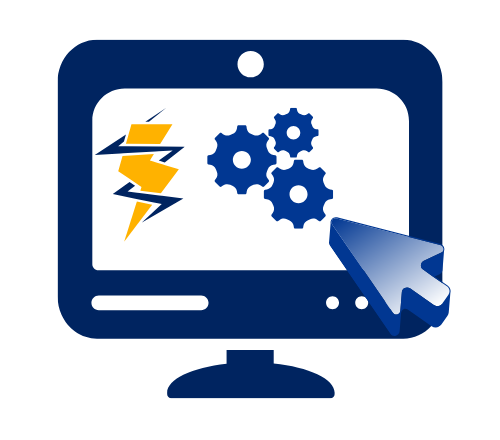Energy Usage calculator
Millions of households struggle with unexpectedly high power bills—often without understanding which devices drive up costs each month.
Using an energy usage calculator, you can quickly estimate how many kilowatt-hours each appliance consumes, then translate that into your local cost per kWh to see exactly where your money goes.
Simply enter device wattage, daily usage hours, and days of operation to get real-time results—no technical background needed.
How the Energy Usage Calculator Works
1. Input Your Appliance Details
- List each device: from refrigerators and lights to TVs and chargers.
- Enter wattage (found on the label or manual) or select from common presets (e.g., 60 W bulb, 1,500 W space heater).
- Specify daily usage (hours/day) and days used per month.
2. Automatic Calculation
- The tool applies the formula:
Energy (kWh) = (Wattage × Hours/Day × Days/Month) ÷ 1000
- Results update instantly, showing energy consumed per device.
3. Estimate Monthly Electricity Cost
- Enter your local rate (e.g., $0.15/kWh).
- The calculator multiplies total kWh by rate to display your monthly cost per device and overall bill estimate.
Why You Should Track Your Electricity Consumption
1. Understand Where Your Money Goes
Over 50 percent of household energy use goes to heating and cooling alone (52 % in 2020) EIA. By pinpointing your top energy-hungry appliances, you can target the biggest savings first.
Curious how much more you can save? Explore how energy monitoring can maximize your home efficiency.
Case Study – London Retrofit
A multi-project renovation of a Greater London home (loft insulation, double-glazed windows, LED lighting) saved the average family 9 MWh/year, cut 1,700 kg CO₂, and reduced bills by £800 annually at an 11-year payback arXiv.
2. Make Informed Decisions
Switching to energy-efficient appliances pays off. For example, replacing a 100 W incandescent bulb with a 12 W LED saves up to 90 percent of lighting energy—and around $29/year per bulb at $0.114/kWh The Department of Energy’s Energy.gov. Do you Want to upgrade smartly? See our guide to choosing efficient smart plugs.
3. Reduce Carbon Footprint
Every kWh saved cuts carbon emissions. In the U.S., the average home uses 30–33 kWh per day, or about 10,500 kWh per year. Habits like unplugging “vampire” devices (which draw 5–10 percent of residential use in standby) can shrink both bills and emissions.

Tips for Accurate Electricity Usage Calculation
1. Check Appliance Wattage
Find it on the product label or manual. For precision, use a plug-in watt-meter to measure real draw.
2. Consider Seasonal Usage
Account for heavier use of heaters or air conditioners in winter/summer months—adjust days/month accordingly.
For full control over seasonal variations, see how whole-house energy monitors work in all climates.
3. Don’t Forget Standby Power
“Phantom” loads (TVs, game consoles, chargers) can add 5–10 percent to your bill. Use switched power strips to cut off power completely when devices are idle standby.lbl.gov.
Conclusion
An electricity usage calculator is your first step toward smarter energy use, lower bills, and a smaller carbon footprint. It’s free, fast, and puts you in control.
Ready for the next step? Consider setting up a full home energy monitoring system to automate your insights and savings.
FAQs
An energy usage calculator is a tool that helps estimate how much electricity your appliances and devices consume over time. By inputting power ratings (in watts) and usage hours, you can calculate the energy consumption in kilowatt-hours (kWh) and estimate your monthly electricity cost.
The calculator multiplies the wattage of your device by the number of hours it is used per day and then converts it into kilowatt-hours (kWh). It then multiplies the result by your local electricity rate to provide an estimate of your energy cost.
Formula:(Wattage × Hours Used per Day × Days per Month) ÷ 1000 = Monthly kWh)
Using an energy usage calculator helps you:
Identify high-energy-consuming appliances
Monitor your electricity usage
Reduce your electricity bill
Make better decisions on energy-saving devices
The calculator provides a close estimate based on the data you enter. For best accuracy, use actual device wattage (found on labels or manuals) and exact usage hours. The actual bill may vary slightly due to additional charges and variable tariffs.
To calculate your energy usage, you typically need:
Appliance/device name
Power rating in watts (W)
Daily usage time (in hours)
Electricity cost per kWh (check your bill)
Yes. By identifying which appliances use the most energy, you can take action to:
Unplug idle devices
Upgrade to energy-efficient appliances
Adjust usage times
Optimize your home energy management
This calculator is primarily designed for home and office energy usage. However, it can be used for basic industrial calculations as well, as long as you input the correct power values and usage data.
kWh (kilowatt-hour) is the unit used by utility companies to measure energy consumption. One kilowatt-hour means using 1000 watts for one hour. It’s the standard for calculating your electricity bill.
You can usually find the wattage:
On the appliance label (back or bottom)
In the product manual
On manufacturer websites or product listings
If it’s not listed, you can use a watt meter to measure real-time consumption.
Yes, our energy usage calculator is 100% free to use. It’s an online tool designed to help you understand and manage your electricity consumption more effectively.

